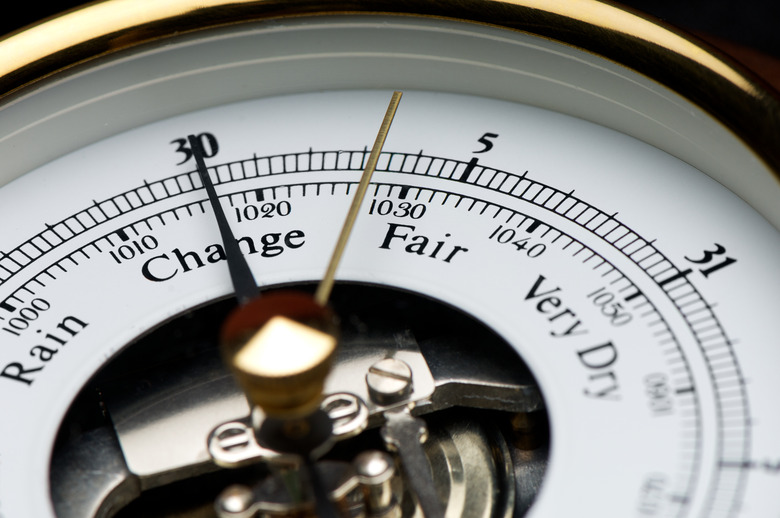How To Find Barometric Pressure In My Area
When watching weather forecasts, you may see meteorologists refer to predicted or in-progress drops in barometric pressure in your area. The meteorologist may offer this information in conjunction with a dour forecast, such as wind gusts and rain.
What is this mysterious quantity, what creates it, and how does it relate to other weather conditions in the region of interest? Read on, and you'll be able to wow your classmates and friends with a few new tidbits of atmospheric science knowledge.
What Is Pressure in Physics?
What Is Pressure in Physics?
Pressure is a measure of the amount of force applied to an object or theoretical plane per unit area.
You get a sense of the relationship between force, area and pressure by performing the following exercise: Use a given amount of force to apply the side of a die to your arm, and then apply the same amount of force to push the tip of a pen against your arm. You will feel the pen push much more as a result of the effective concentration of the applied force to a small area.
In mathematical terms:
\(P = \dfrac{F}{A}\)
What Is Barometric Pressure?
What Is Barometric Pressure?
Although you are not conscious of it thanks to your body being adapted for life here on Earth, air has weight, which is a force. That means that if you take a horizontal plane of known area and weigh the column of air above it, you can calculate atmospheric pressure. Such a device is known as a **barometer.**
- Normal atmospheric pressure is in the range of 1 atm = 101.325 kilopascal (kPa) = 760 millimeters of mercury (mm Hg or torr) = 14.7 pounds per square inch (psi). See the Resources for a conversion tool to work between these and other units of pressure.
When the barometric pressure is dropping in a given area, this usually portends clouds, wind and precipitation—unpleasant weather in general. High-pressure systems, on the other hand, often precede calmer and more pleasant conditions.
Finding "Your" Barometric Pressure
Finding "Your" Barometric Pressure
If you live in the U.S., to find the barometric pressure for your city, another municipality or a national park or other attraction on a given day in history, visit the National Weather Service online. Type your zip code or city, state into the search box in the upper left of the screen. You will then see local information for humidity, wind speed, dew point and visibility in addition to barometric pressure.
You can also use the "Past Weather" tab at the top of the screen to review barometric data from any day in the past (to a reasonable point).
How Does Barometric Pressure Affect Humans?
How Does Barometric Pressure Affect Humans?
Rapid barometric pressure changes can cause physical difficulties, especially in genetically susceptible people. For example, some people are prone to a phenomenon called decompression sickness. This can manifest in a couple of ways:
- High-altitude sickness, when people who live in regions with typical sea-level barometric pressure readings ascend too quickly to high elevations, such as that of Colorado Springs, U.S. (about 6,000' to 7,000').
- "The bends," which occurs when scuba divers surface too quickly after their bodies have become acclimated to the very high pressures experienced even a 100 feet below the surface of water. (Water weighs far more than air, so the weight of any column of water over a given surface area increases rapidly with increasing depth.)
- As you ascend in an airplane, the atmospheric pressure drops to lower values than the pressure of the air interior to your eardrums. Your ears then often "pop" because they are trying to equalize, or match, the pressure on the outside (in the airplane cabin). The same thing happens in reverse when the plane descends, and your ears have to adjust to an ever-higher atmospheric pressure until you land.
Cite This Article
MLA
Beck, Kevin. "How To Find Barometric Pressure In My Area" sciencing.com, https://www.sciencing.com/barometric-pressure-area-5877559/. 8 February 2020.
APA
Beck, Kevin. (2020, February 8). How To Find Barometric Pressure In My Area. sciencing.com. Retrieved from https://www.sciencing.com/barometric-pressure-area-5877559/
Chicago
Beck, Kevin. How To Find Barometric Pressure In My Area last modified August 30, 2022. https://www.sciencing.com/barometric-pressure-area-5877559/
